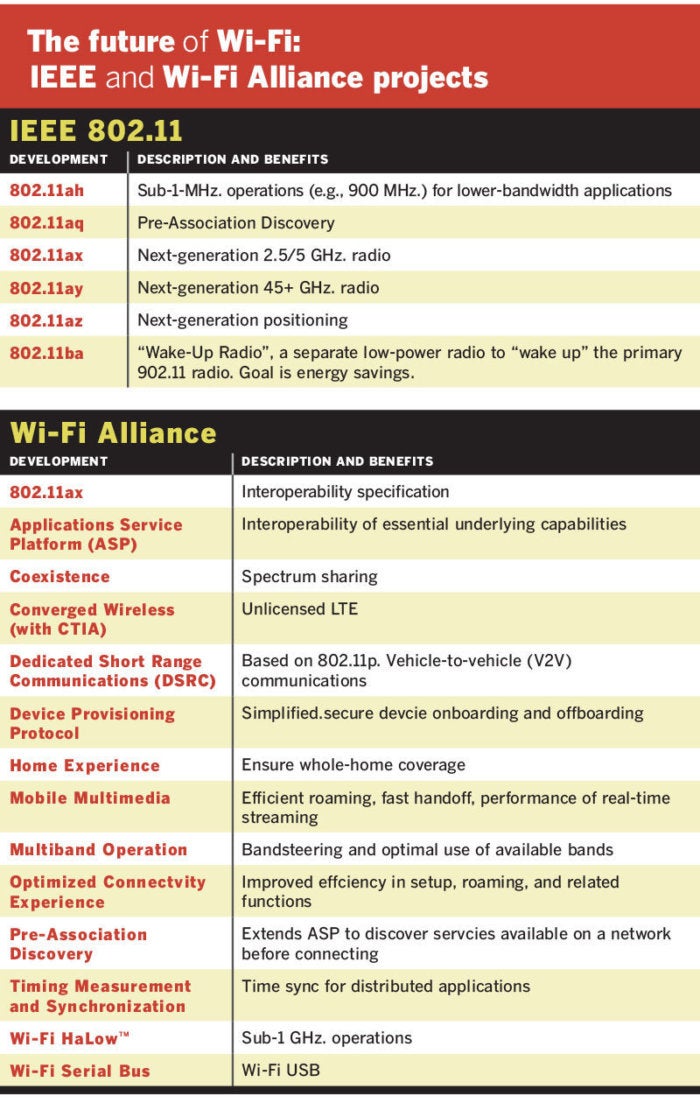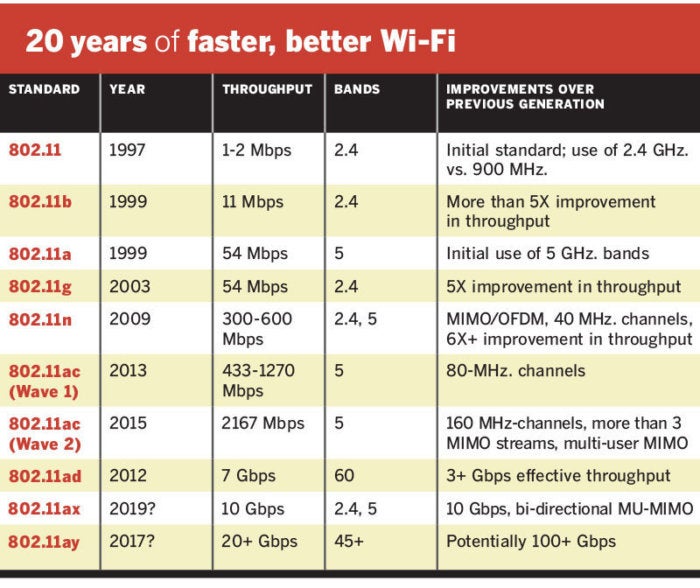With today’s gigabit-plus speeds, broad features and capabilities, and impressive price/performance, one might assume that we’re approaching the time when we can close the wireless LAN patent office.
And yet a remarkably high level of activity continues in numerous dimensions of Wi-Fi technologies, including new physical layers, advances within the IEEE 802.11 Working Group, at Wi-Fi Alliance, and in a broad range of applications, from mission-critical real-time enterprise requirements to the Internet of Things.
In fact, there are no signs that the rate of Wi-Fi innovation is even slowing. Indeed, the next five years will reveal a remarkable number of advances, with new generations of products that keep pace with a broad range of real-world requirements beyond just higher throughput. This article will describe the current major activities in Wi-Fi technologies and products, and explore the key issues and challenges that remain.
Current challenges: Latency, density and the 60 GHz band
It’s hard to believe that it’s been 20 years since the first (1997) IEEE 802.11 standard – a groundbreaking effort that enabled wireless LANs to reach a whopping 1M and 2Mbps. But even as new standards under development shoot at 10 and even 20+ Gbps, the real issues and opportunities surrounding the future of Wi-Fi have less to do with throughput.
Instead, the core issues – and opportunities – today are capacity, cost, management, and support for every application from low-throughput, high-latency IoT to streaming 4K video. But more throughput, of course, never hurts.
While Wave 2 (an unofficial but sticky term) of 802.11ac embodies the state of the Wi-Fi art, it by no means defines an upper bound on WLAN performance. 802.11ad defines similar – close to 7Gbps – performance, but in the 60 GHz. unlicensed ISM bands. As was the case with the first 5-GHz. standard, 802.11a, network teams have shied away from a consideration of 60 GHz. primarily due to concerns about limited range.
As it turns out, that limited range is often desirable so as to enable denser deployment of access points and thus more efficient geographic reuse of available channels – increasingly important as Wi-Fi channel bandwidths have grown from 20 to 40, 80, and even 160 MHz., and thus resulting in fewer simultaneous channels being available in any given physical location.
With 7 to 9 GHz. of spectrum available, depending upon the country, 60 GHz. suffers from no shortage of available bandwidth – but the vendor community has been slow to produce products, given a lack of customer demand and the ability of 802.11ac to meet all current application demands.
We suspect, however, that the adoption of 60 GHz. is inevitable, as the number of users, devices, and applications demanding reduced latency, if not higher throughput, continue to grow.
On the horizon: IEEE 802.11ax, 802.11ay, and more
To address those demands, most current industry attention is focused on the upcoming 802.11ax standard, which seeks to achieve 10Gbps in the 5-GHz bands, but which will also, unlike 802.11ac, be deployable at 2.4 GHz.
This will, hopefully, provide the final incentive required to obsolete any devices limited to standards before 802.11n. While 802.11ax is still in development, we expect it to incorporate orthogonal frequency division multiple access (OFDMA), bi-directional multi-user MIMO (802.11ac MU-MIMO is downlink only), and likely a few other enhancements designed to improve efficiency and reliability. We expect to see initial 802.11ax products in 2018, even as the standard won’t be completely finished until early 2019.
On the 60-GHz front, even though 802.11ad has yet to establish a foothold, a follow-on technology, 802.11ay, is shooting at 20+ and perhaps even in excess of 100Gbps. Again, though, as raw throughput loses its relative importance, 802.11ay may, like 802.11ad, see limited demand.
We suspect, though, that even with 802.11ax, demand for additional spectrum will drive at least a meaningful percentage of users up the experience curve to the wide open spaces of 60 GHz, and 802.11ay could prove much more popular over time than might be assumed today.
Other activities underway at 802.11 include 802.11aq (Pre-Association Discovery) and 802.11az (Next-Generation Positioning). 802.11aq enables users to determine what services might be available on a given network before going through the association process and connecting, and 802.11az applies round-trip timing to location, tracking, and positioning, which should provide more accurate results than the current method.
We expect .11az to drive competition with Bluetooth LE-based beacons, which clearly have the momentum lead in indoor positioning applications.
Wi-Fi Alliance: Top priorities
Wi-Fi Alliance, arguably the most successful trade association ever, was initially formed to provide interoperability testing and certification for the rapidly-emerging 802.11 world. This activity contributed greatly to the overall early success of 802.11, as the IEEE does not provide certification, compliance, or performance testing.
Wi-Fi Alliance has expanded its role over time. For example, it developed Wi-Fi Protected Access (WPA) in response to the compromise of 802.11’s WEP security. More recently, it acquired the Wireless Gigabit Alliance (WiGig) to promote 60 GHz. Today, Wi-Fi Alliance is active in a broad range of areas, with a few standing out:
- 802.11ax certification – In a recent conversation with Edgar Figueroa, the CEO of Wi-Fi Alliance, he said that “it would not be surprising” to see an interim Wi-Fi certification for 802.11ax before the publication of the final standard, thus following a pattern that has prevailed with recent 802.11 PHY advances and accelerating the availability of 802.11ax products.
- Improved user experience – Focusing on capacity, density, and multiband operations is a top priority, he adds. The work in multiband operations may result in a standardization (in the trade-association, as opposed to formal-standards-body, sense) of bandsteering capabilities already available in proprietary form in many enterprise-class Wi-Fi systems today.
- Optimized connectivity experience – Figueroa also noted work in improving the speed of link setup (IEEE 802.11ai is also active here) and connection, picking the best access point at any given moment in time, and dealing with sticky clients that refuse to roam even though an improvement in both client-specific and system-wide performance could be realized via such a move.
Spectrum issues
Another very interesting and important Wi-Fi activity focuses on the critical issue of the availability of spectrum, coexisting with other contenders for that spectrum (most notably LTE operating in the unlicensed bands).
Wi-Fi Alliance recently published a report that estimates that between 500 MHz. and 1 GHz. of “new” spectrum, depending upon location, will be required by 2025 to handle anticipated growth in Wi-Fi traffic.
We believe it is unlikely that regulators will allocate that much spectrum to unlicensed uses. The model used in the study assumes 10-20% of traffic will use the 60 GHz. bands, which again leads us to conclude the 802.11ad and .11ay may see greater deployment than many currently believe.
On the other hand, we believe it unlikely that the TV White Space bands addressed by 802.11af will see much activity given the limited size of the channels available here. Still, some outdoor IoT activity might be addressed by this spectrum, and Wi-Fi Alliance is also active in the IoT space
Given the limited range of most enterprise Wi-Fi links, the greatest challenge to spectrum may be coming from increasing interest in deploying LTE in the unlicensed bands via LAA-LTE and LTE-U. Currently there is little evidence that Wi-Fi will peacefully coexist with deployments of this type.
Given, that most enterprises have direct control of the systems and solutions deployed within their walls, this issue will likely be of only minor concern to the vast majority of organizations. Public spaces, however, and residential settings may be at risk over time. We think the best answer would be a hard handoff between cellular and Wi-Fi links, something the alliance is working on.
Wi-Fi and IoT
A wide variety of other Wi-Fi developments are currently seeing significant activity across a very broad frontier of applications and markets. There’s significant evidence that Wi-Fi will in fact dominate the IoT market over time. Many Wi-Fi implementations have the power, form factor, component cost, and related physical and electronic characteristics to enable Wi-Fi to find a home in essentially any IoT application, broadband or otherwise.
And, most importantly, Wi-Fi-based IoT clients can leverage existing and common if not ubiquitous infrastructure, dramatically reducing cost-to-solution. Many IoT applications will likely find a home in the 900-MHz bands that originally hosted early WLANs, and now the domain of 802.11ah.
Dedicated Short-Range Communications (DSRC), which could become important particularly in vehicular applications like autonomous cars, is covered in 802.11p. Wi-Fi’s role in wireless and mobile applications is second to none, and there is no replacement technology on the horizon.
Wi-Fi becomes cultural
The breadth and depth of the opportunities to deploy Wi-Fi in applications beyond the common end-user network access is compelling. While Bluetooth will remain the technology of choice for headsets and audio links for music and telephony, Wi-Fi will extend its dominance in the enterprise, the residence, high-density public-spaces, and into the newer applications and market opportunities.
Hospitals will use Wi-Fi for in-building and campus directions, real-time electronic medical records updates, and augmented-reality surgery. Enterprises will expand their Wi-Fi networks to handle building security, surveillance, environmental and energy monitoring and control, and real-time video distribution.
Wi-Fi’s mantra today might indeed be every application, everywhere. Wi-Fi has in fact become cultural, with coverage and capacity now an expectation and requirement almost everywhere today. And that is not going to change.
Sources: Networkworld
Hey My Readers and Visitirs If You Like Us or Our Web Site Please Share and Link back To My Site ... Take Care .,.,.



























.png)
0 comments:
Post a Comment